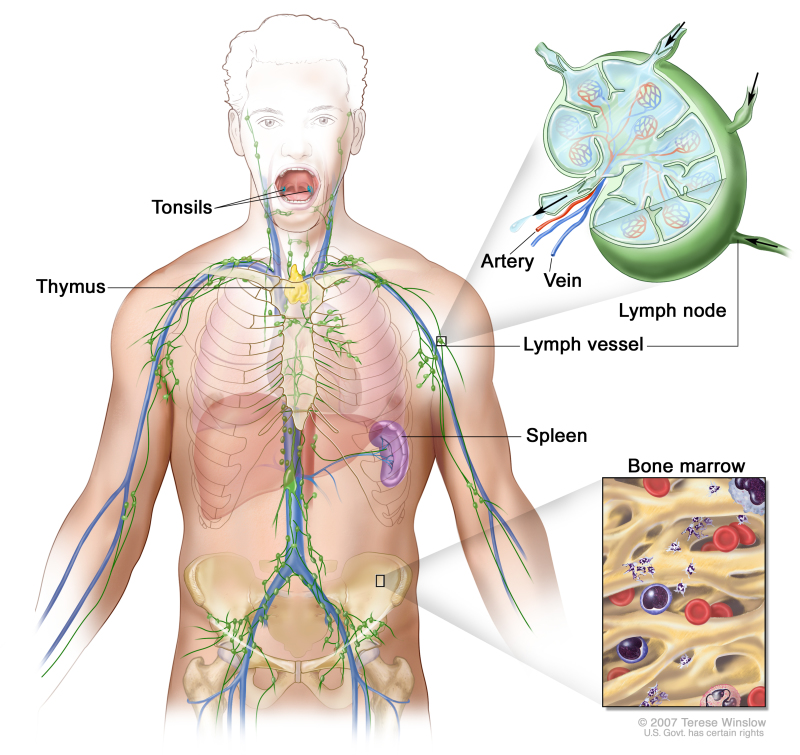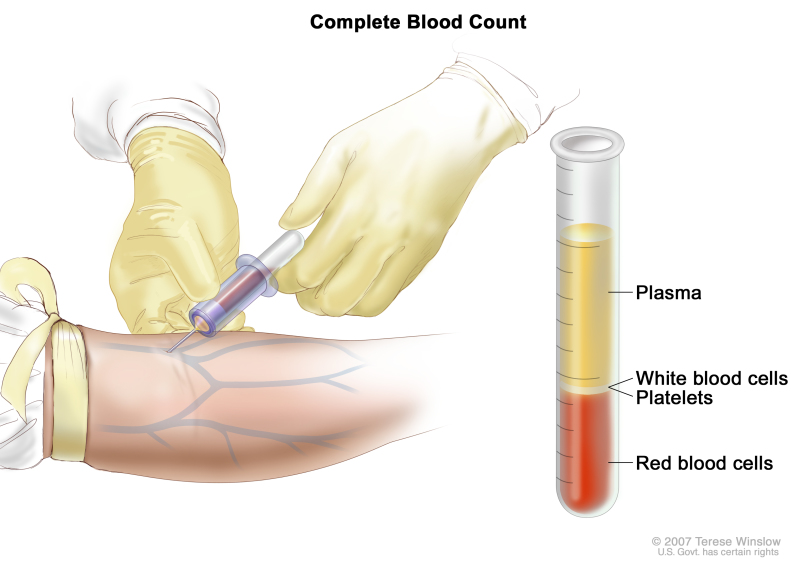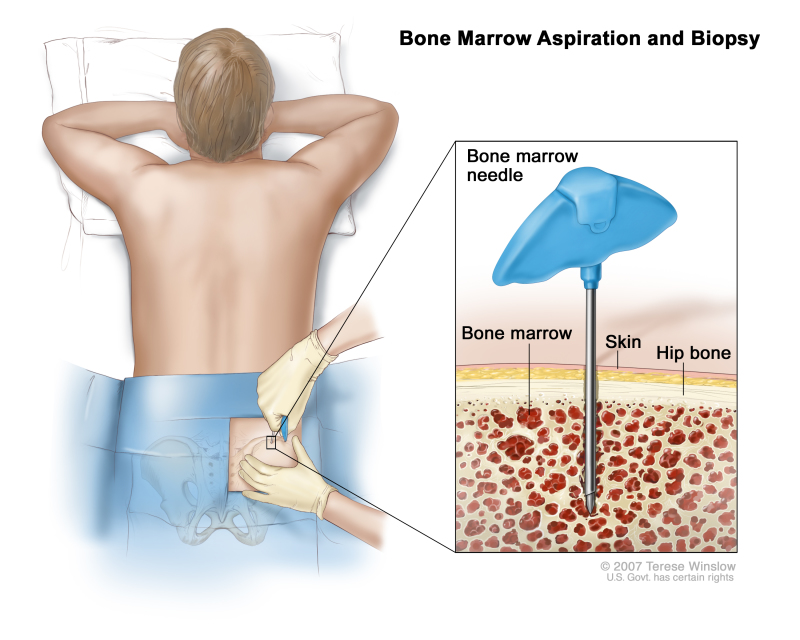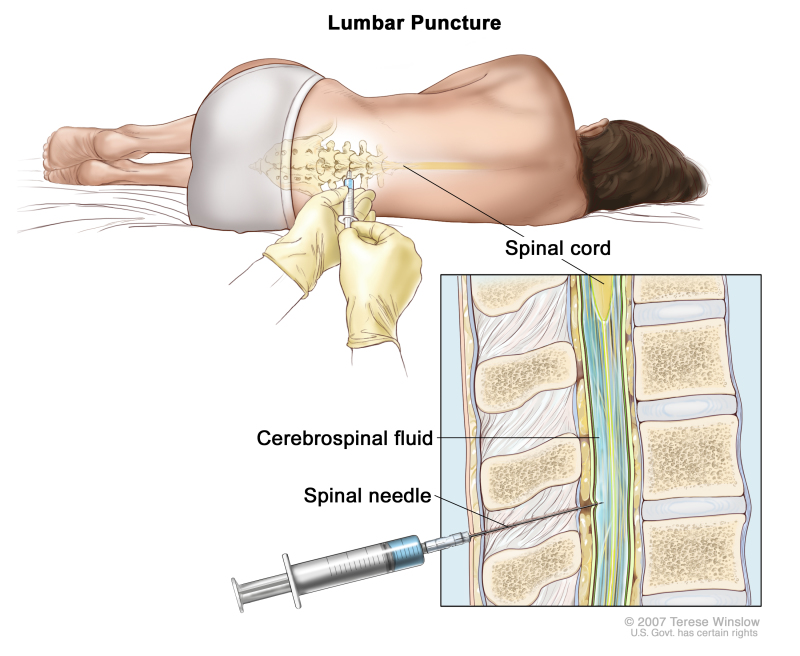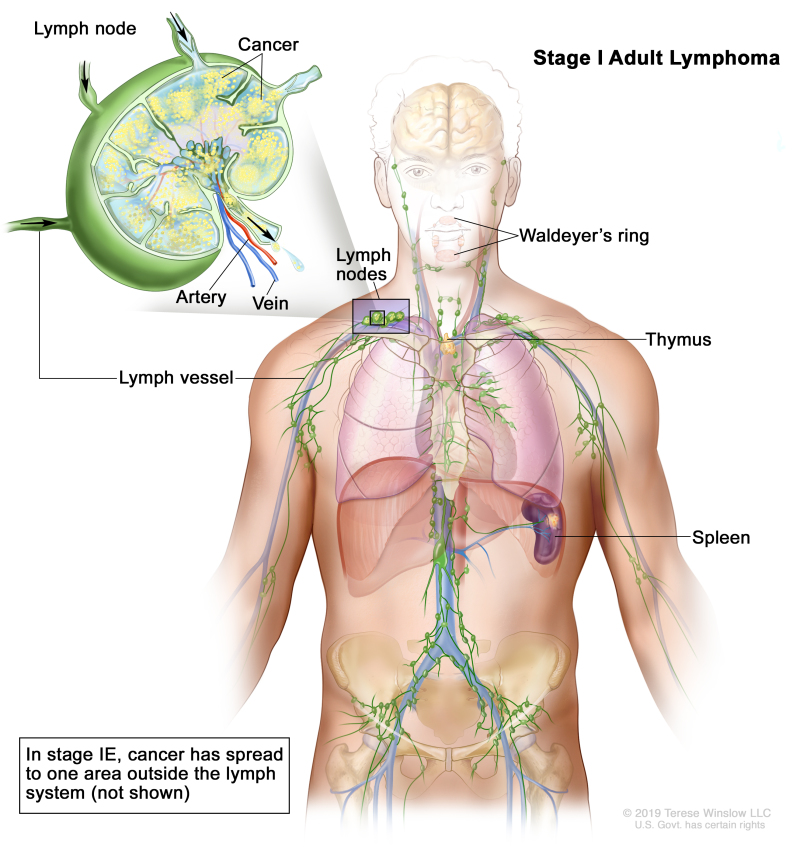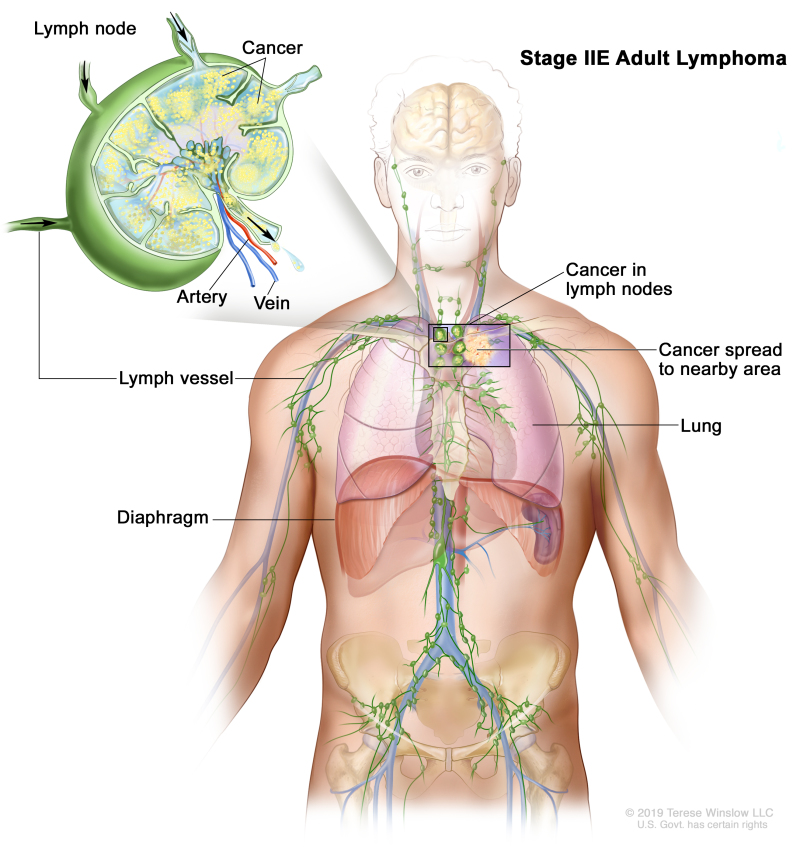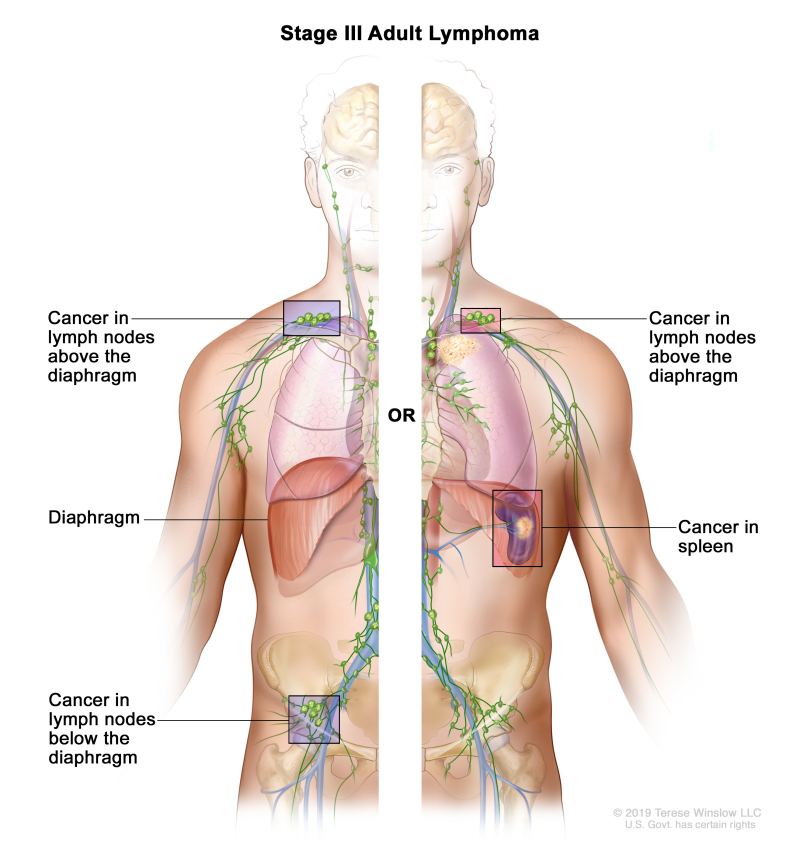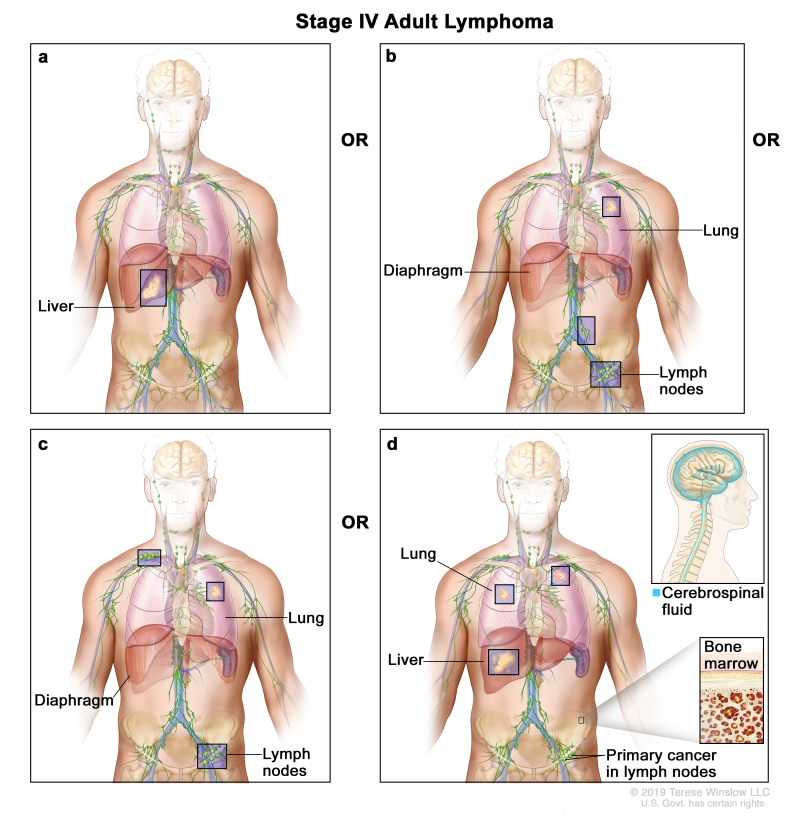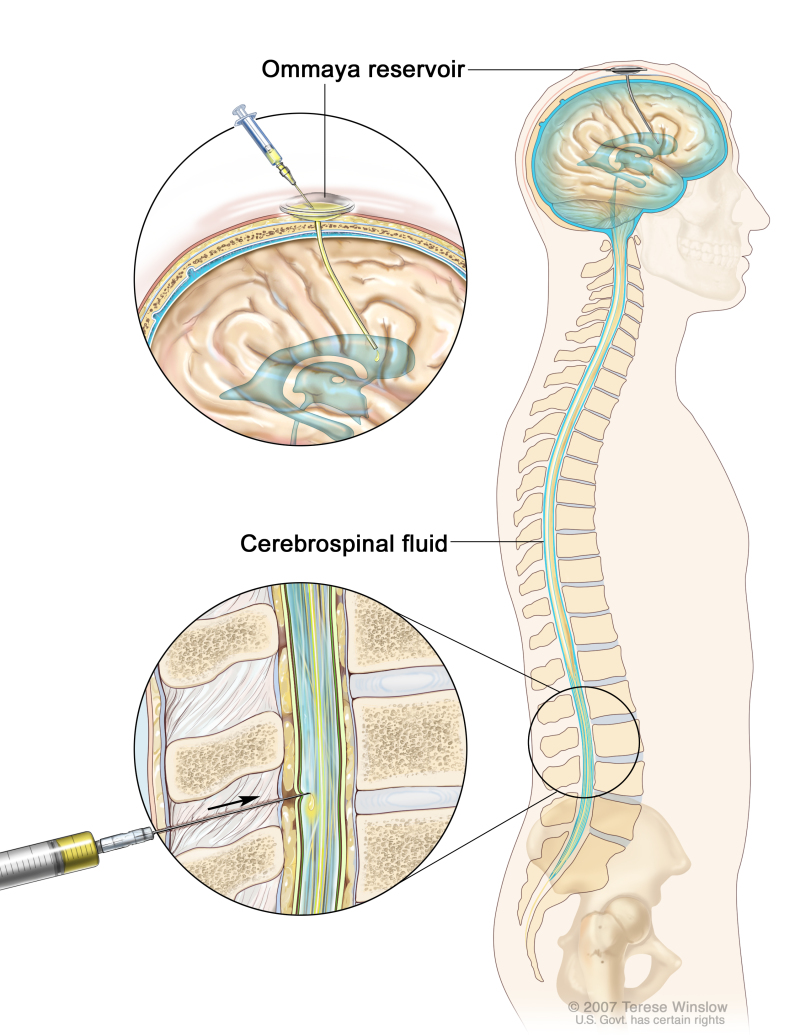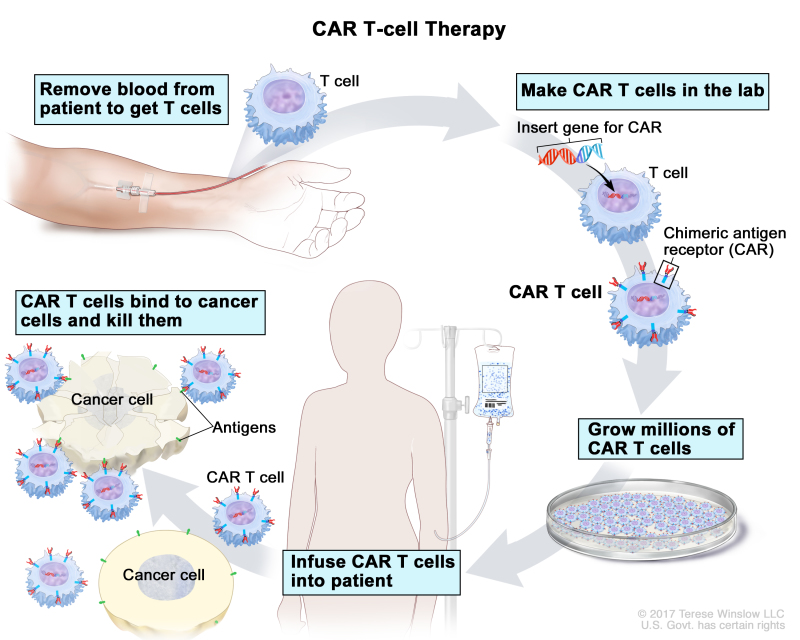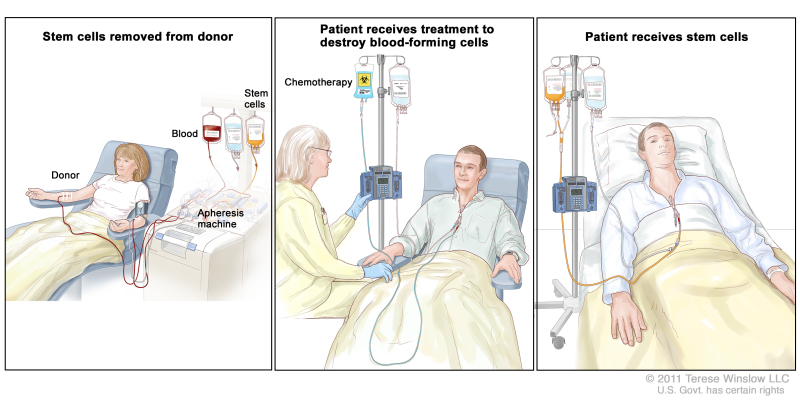NCBI Bookshelf. A service of the National Library of Medicine, National Institutes of Health.
PDQ Cancer Information Summaries [Internet]. Bethesda (MD): National Cancer Institute (US); 2002-.

PDQ Cancer Information Summaries [Internet].
Show detailsThis PDQ cancer information summary has current information about the treatment of adult non-Hodgkin lymphoma. It is meant to inform and help patients, families, and caregivers. It does not give formal guidelines or recommendations for making decisions about health care.
Editorial Boards write the PDQ cancer information summaries and keep them up to date. These Boards are made up of experts in cancer treatment and other specialties related to cancer. The summaries are reviewed regularly and changes are made when there is new information. The date on each summary ("Date Last Modified") is the date of the most recent change. The information in this patient summary was taken from the health professional version, which is reviewed regularly and updated as needed, by the PDQ Adult Treatment Editorial Board.
General Information About Adult Non-Hodgkin Lymphoma
Key Points for This Section
Non-Hodgkin lymphoma is a disease in which malignant (cancer) cells form in the lymph system.
Non-Hodgkin lymphoma is a type of cancer that forms in the lymph system. The lymph system is part of the immune system. It helps protect the body from infection and disease.
The lymph system is made up of the following:
- Lymph: Colorless, watery fluid that travels through the lymph vessels and carries lymphocytes (white blood cells). There are three types of lymphocytes:
- B lymphocytes that make antibodies to help fight infection. Also called B cells. Most types of non-Hodgkin lymphoma begin in B lymphocytes.
- T lymphocytes that help B lymphocytes make the antibodies that help fight infection. Also called T cells.
- Lymph vessels: A network of thin tubes that collect lymph from different parts of the body and return it to the bloodstream.
- Lymph nodes: Small, bean-shaped structures that filter lymph and store white blood cells that help fight infection and disease. Lymph nodes are found along a network of lymph vessels throughout the body. Groups of lymph nodes are found in the neck, underarm, mediastinum, abdomen, pelvis, and groin.
- Spleen: An organ that makes lymphocytes, stores red blood cells and lymphocytes, filters the blood, and destroys old blood cells. The spleen is on the left side of the abdomen near the stomach.
- Thymus: An organ in which T lymphocytes mature and multiply. The thymus is in the chest behind the breastbone.
- Bone marrow: The soft, spongy tissue in the center of certain bones, such as the hip bone and breastbone. White blood cells, red blood cells, and platelets are made in the bone marrow.
Anatomy of the lymph system, showing the lymph vessels and lymph organs including lymph nodes, tonsils, thymus, spleen, and bone marrow. Lymph (clear fluid) and lymphocytes travel through the lymph vessels and into the lymph nodes where the lymphocytes destroy harmful substances. The lymph enters the blood through a large vein near the heart.
Lymph tissue is also found in other parts of the body such as the lining of the digestive tract, bronchus, and skin. Cancer can spread to the liver and lungs.
There are two general types of lymphomas: Hodgkin lymphoma and non-Hodgkin lymphoma. This summary is about the treatment of adult non-Hodgkin lymphoma, including during pregnancy.
For information about other types of lymphoma, see the following PDQ summaries:
- Adult Acute Lymphoblastic Leukemia Treatment (lymphoblastic lymphoma)
- Chronic Lymphocytic Leukemia Treatment (small lymphocytic lymphoma)
- Mycosis Fungoides (Including Sézary Syndrome) Treatment (cutaneous T-cell lymphoma)
Non-Hodgkin lymphoma can be indolent or aggressive.
Non-Hodgkin lymphoma grows and spreads at different rates and can be indolent or aggressive. Indolent lymphoma tends to grow and spread slowly, and has few signs and symptoms. Aggressive lymphoma grows and spreads quickly, and has signs and symptoms that can be severe. The treatments for indolent and aggressive lymphoma are different.
This summary is about the following types of non-Hodgkin lymphoma:
Indolent non-Hodgkin lymphomas
- Follicular lymphoma. Follicular lymphoma is the most common type of indolent non-Hodgkin lymphoma. It is a very slow-growing type of non-Hodgkin lymphoma that begins in B lymphocytes. It affects the lymph nodes and may spread to the bone marrow or spleen. Most patients with follicular lymphoma are age 50 years and older when they are diagnosed. Follicular lymphoma may go away without treatment. The patient is closely watched for signs or symptoms that the disease has come back. Treatment is needed if signs or symptoms occur after the cancer disappeared or after initial cancer treatment. Sometimes follicular lymphoma can become a more aggressive type of lymphoma, such as diffuse large B-cell lymphoma.
- Lymphoplasmacytic lymphoma. In most cases of lymphoplasmacytic lymphoma, B lymphocytes that are turning into plasma cells make large amounts of a protein called monoclonal immunoglobulin M (IgM) antibody. High levels of IgM antibody in the blood cause the blood plasma to thicken. This may cause signs or symptoms such as trouble seeing or hearing, heart problems, shortness of breath, headache, dizziness, and numbness or tingling of the hands and feet. Sometimes there are no signs or symptoms of lymphoplasmacytic lymphoma. It may be found when a blood test is done for another reason. Lymphoplasmacytic lymphoma often spreads to the bone marrow, lymph nodes, and spleen. Patients with lymphoplasmacytic lymphoma should be checked for hepatitis C virus infection. It is also called Waldenström macroglobulinemia.
- Marginal zone lymphoma. This type of non-Hodgkin lymphoma begins in B lymphocytes in a part of lymph tissue called the marginal zone. The prognosis may be worse for patients aged 70 years or older, those with stage III or stage IV disease, and those with high lactate dehydrogenase (LDH) levels. There are five different types of marginal zone lymphoma. They are grouped by the type of tissue where the lymphoma formed:
- Nodal marginal zone lymphoma. Nodal marginal zone lymphoma forms in lymph nodes. This type of non-Hodgkin lymphoma is rare. It is also called monocytoid B-cell lymphoma.
- Gastric mucosa-associated lymphoid tissue (MALT) lymphoma. Gastric MALT lymphoma usually begins in the stomach. This type of marginal zone lymphoma forms in cells in the mucosa that help make antibodies. Patients with gastric MALT lymphoma may also have Helicobacter gastritis or an autoimmune disease, such as Hashimoto thyroiditis or Sjögren syndrome.
- Extragastric MALT lymphoma. Extragastric MALT lymphoma begins outside of the stomach in almost every part of the body including other parts of the gastrointestinal tract, salivary glands, thyroid, lung, skin, and around the eye. This type of marginal zone lymphoma forms in cells in the mucosa that help make antibodies. Extragastric MALT lymphoma may come back many years after treatment.
- Mediterranean abdominal lymphoma. This is a type of MALT lymphoma that occurs in young adults in eastern Mediterranean countries. It often forms in the abdomen and patients may also be infected with bacteria called Campylobacter jejuni. This type of lymphoma is also called immunoproliferative small intestinal disease.
- Splenic marginal zone lymphoma. This type of marginal zone lymphoma begins in the spleen and may spread to the peripheral blood and bone marrow. The most common sign of this type of splenic marginal zone lymphoma is a spleen that is larger than normal.
- Primary cutaneous anaplastic large cell lymphoma. This type of non-Hodgkin lymphoma is in the skin only. It can be a benign (not cancer) nodule that may go away on its own or it can spread to many places on the skin and need treatment.
Older age, being male, and having a weakened immune system can increase the risk of adult non-Hodgkin lymphoma.
Anything that increases your risk of getting a disease is called a risk factor. Having a risk factor does not mean that you will get cancer; not having risk factors doesn’t mean that you will not get cancer. Talk with your doctor if you think you may be at risk.
These and other risk factors may increase the risk of certain types of adult non-Hodgkin lymphoma:
- Being older, male, or white.
- Having one of the following medical conditions that weakens the immune system:
- -
An inherited immune disorder (such as hypogammaglobulinemia or Wiskott-Aldrich syndrome).
- -
An autoimmune disease (such as rheumatoid arthritis, psoriasis, or Sjögren syndrome).
- -
HIV/AIDS.
- -
Human T-lymphotrophic virus type I or Epstein-Barr virus infection.
- -
Helicobacter pylori infection.
- Taking immunosuppressant drugs after an organ transplant.
Signs and symptoms of adult non-Hodgkin lymphoma include swollen lymph nodes, fever, drenching night sweats, weight loss, and fatigue.
These signs and symptoms may be caused by adult non-Hodgkin lymphoma or by other conditions. Check with your doctor if you have any of the following:
- Swelling in the lymph nodes in the neck, underarm, groin, or stomach.
- Fever for no known reason.
- Drenching night sweats.
- Feeling very tired.
- Weight loss for no known reason.
- Skin rash or itchy skin.
- Pain in the chest, abdomen, or bones for no known reason.
When fever, drenching night sweats, and weight loss occur together, this group of symptoms is called B symptoms.
Other signs and symptoms of adult non-Hodgkin lymphoma may occur and depend on the following:
- Where the cancer forms in the body.
- The size of the tumor.
- How fast the tumor grows.
Tests that examine the lymph system and other parts of the body are used to help diagnose and stage adult non-Hodgkin lymphoma.
The following tests and procedures may be used:
- Physical exam and health history: An exam of the body to check general signs of health, including checking for signs of disease, such as lumps or anything else that seems unusual. A history of the patient’s health, including fever, night sweats, and weight loss, health habits, and past illnesses and treatments will also be taken.
- Complete blood count (CBC): A procedure in which a sample of blood is drawn and checked for the following:
- -
The number of red blood cells, white blood cells, and platelets.
- -
The amount of hemoglobin (the protein that carries oxygen) in the red blood cells.
- -
The portion of the sample made up of red blood cells.
Complete blood count (CBC). Blood is collected by inserting a needle into a vein and allowing the blood to flow into a tube. The blood sample is sent to the laboratory and the red blood cells, white blood cells, and platelets are counted. The CBC is used to test for, diagnose, and monitor many different conditions.
- Blood chemistry studies: A procedure in which a blood sample is checked to measure the amounts of certain substances released into the blood by organs and tissues in the body. An unusual (higher or lower than normal) amount of a substance can be a sign of disease.
- LDH test: A procedure in which a blood sample is checked to measure the amount of lactic dehydrogenase. An increased amount of LDH in the blood may be a sign of tissue damage, lymphoma, or other diseases.
- Hepatitis B and hepatitis C test: A procedure in which a sample of blood is checked to measure the amounts of hepatitis B virus-specific antigens and/or antibodies and the amounts of hepatitis C virus-specific antibodies. These antigens or antibodies are called markers. Different markers or combinations of markers are used to determine whether a patient has a hepatitis B or C infection, has had a prior infection or vaccination, or is susceptible to infection. Patients who have been treated for hepatitis B virus in the past need continued monitoring to check if it has reactivated. Knowing whether a person has hepatitis B or C may help plan treatment.
- CT scan (CAT scan): A procedure that makes a series of detailed pictures of areas inside the body, such as the neck, chest, abdomen, pelvis, and lymph nodes, taken from different angles. The pictures are made by a computer linked to an x-ray machine. A dye may be injected into a vein or swallowed to help the organs or tissues show up more clearly. This procedure is also called computed tomography, computerized tomography, or computerized axial tomography.
- PET scan (positron emission tomography scan): A procedure to find malignant tumor cells in the body. A small amount of radioactive glucose (sugar) is injected into a vein. The PET scanner rotates around the body and makes a picture of where glucose is being used in the body. Malignant tumor cells show up brighter in the picture because they are more active and take up more glucose than normal cells do.
- Bone marrow aspiration and biopsy: The removal of bone marrow and a small piece of bone by inserting a needle into the hipbone or breastbone. A pathologist views the bone marrow and bone under a microscope to look for signs of cancer.
- Lymph node biopsy: The removal of all or part of a lymph node. A pathologist views the tissue under a microscope to check for cancer cells. One of the following types of biopsies may be done:
- -
Excisional biopsy: The removal of an entire lymph node.
- -
Incisional biopsy: The removal of part of a lymph node.
- -
Core biopsy: The removal of part of a lymph node using a wide needle.
If cancer is found, the following tests may be done to study the cancer cells:
- Immunohistochemistry: A laboratory test that uses antibodies to check for certain antigens (markers) in a sample of a patient’s tissue. The antibodies are usually linked to an enzyme or a fluorescent dye. After the antibodies bind to a specific antigen in the tissue sample, the enzyme or dye is activated, and the antigen can then be seen under a microscope. This type of test is used to help diagnose cancer and to help tell one type of cancer from another type of cancer.
- Cytogenetic analysis: A laboratory test in which the chromosomes of cells in a sample of blood or bone marrow are counted and checked for any changes, such as broken, missing, rearranged, or extra chromosomes. Changes in certain chromosomes may be a sign of cancer. Cytogenetic analysis is used to help diagnose cancer, plan treatment, or find out how well treatment is working.
- Immunophenotyping: A laboratory test that uses antibodies to identify cancer cells based on the types of antigens or markers on the surface of the cells. This test is used to help diagnose specific types of lymphoma.
- FISH (fluorescence in situ hybridization): A laboratory test used to look at and count genes or chromosomes in cells and tissues. Pieces of DNA that contain fluorescent dyes are made in the laboratory and added to a sample of a patient’s cells or tissues. When these dyed pieces of DNA attach to certain genes or areas of chromosomes in the sample, they light up when viewed under a fluorescent microscope. The FISH test is used to help diagnose cancer and help plan treatment.
Other tests and procedures may be done depending on the signs and symptoms seen and where the cancer forms in the body.
Certain factors affect prognosis (chance of recovery) and treatment options.
The prognosis and treatment options depend on the following:
- The patient's signs and symptoms, including whether or not they have B symptoms (fever for no known reason, weight loss for no known reason, or drenching night sweats).
- The stage of the cancer (the size of the cancer tumors and whether the cancer has spread to other parts of the body or lymph nodes).
- The type of non-Hodgkin lymphoma.
- The amount of lactate dehydrogenase (LDH) in the blood.
- Whether there are certain changes in the genes.
- The patient’s age, sex, and general health.
- Whether the lymphoma is newly diagnosed, continues to grow during treatment, or has recurred (come back).
For non-Hodgkin lymphoma during pregnancy, treatment options also depend on:
- The wishes of the patient.
- Which trimester of pregnancy the patient is in.
- Whether the baby can be delivered early.
Some types of non-Hodgkin lymphoma spread more quickly than others do. Most non-Hodgkin lymphomas that occur during pregnancy are aggressive. Delaying treatment of aggressive lymphoma until after the baby is born may lessen the mother's chance of survival. Immediate treatment is often recommended, even during pregnancy.
Stages of Adult Non-Hodgkin Lymphoma
Key Points for This Section
After adult non-Hodgkin lymphoma has been diagnosed, tests are done to find out whether cancer cells have spread within the lymph system or to other parts of the body.
The process used to find out the type of cancer and if cancer cells have spread within the lymph system or to other parts of the body is called staging. The information gathered from the staging process determines the stage of the disease. It is important to know the stage of the disease in order to plan treatment. The results of the tests and procedures done to diagnose non-Hodgkin lymphoma are used to help make decisions about treatment.
The following tests and procedures may also be used in the staging process:
- MRI (magnetic resonance imaging) with gadolinium: A procedure that uses a magnet, radio waves, and a computer to make a series of detailed pictures of areas inside the body, such as the brain and spinal cord. A substance called gadolinium is injected into the patient through a vein. The gadolinium collects around the cancer cells so they show up brighter in the picture. This procedure is also called nuclear magnetic resonance imaging (NMRI).
- Lumbar puncture: A procedure used to collect cerebrospinal fluid (CSF) from the spinal column. This is done by placing a needle between two bones in the spine and into the CSF around the spinal cord and removing a sample of the fluid. The sample of CSF is checked under a microscope for signs that the cancer has spread to the brain and spinal cord. This procedure is also called an LP or spinal tap.
Lumbar puncture. A patient lies in a curled position on a table. After a small area on the lower back is numbed, a spinal needle (a long, thin needle) is inserted into the lower part of the spinal column to remove cerebrospinal fluid (CSF, shown in blue). The fluid may be sent to a laboratory for testing.
For pregnant women with non-Hodgkin lymphoma, staging tests and procedures that protect the unborn baby from the harms of radiation are used. These tests and procedures include MRI (without contrast), lumbar puncture, and ultrasound.
There are three ways that cancer spreads in the body.
Cancer can spread through tissue, the lymph system, and the blood:
- Tissue. The cancer spreads from where it began by growing into nearby areas.
- Lymph system. The cancer spreads from where it began by getting into the lymph system. The cancer travels through the lymph vessels to other parts of the body.
- Blood. The cancer spreads from where it began by getting into the blood. The cancer travels through the blood vessels to other parts of the body.
The following stages are used for adult non-Hodgkin lymphoma:
Stage I
Stage I adult lymphoma. Cancer is found in one or more lymph nodes in a group of lymph nodes or, in rare cases, cancer is found in the Waldeyer’s ring, thymus, or spleen. In stage IE (not shown), cancer has spread to one area outside the lymph system.
Stage I adult non-Hodgkin lymphoma is divided into stages I and IE.
In stage I, cancer is found in one of the following places in the lymph system:
- One or more lymph nodes in a group of lymph nodes.
- Waldeyer's ring.
In stage IE, cancer is found in one area outside the lymph system.
Stage II
Stage II adult non-Hodgkin lymphoma is divided into stages II and IIE.
- In stage II, cancer is found in two or more groups of lymph nodes that are either above the diaphragm or below the diaphragm.
- In stage IIE, cancer has spread from a group of lymph nodes to a nearby area that is outside the lymph system. Cancer may have spread to other lymph node groups on the same side of the diaphragm.
In stage II, the term bulky disease refers to a larger tumor mass. The size of the tumor mass that is referred to as bulky disease varies based on the type of lymphoma.
Stage III
Stage III adult lymphoma. Cancer is found in groups of lymph nodes both above and below the diaphragm; or in a group of lymph nodes above the diaphragm and in the spleen.
In stage III adult non-Hodgkin lymphoma, cancer is found:
- in groups of lymph nodes both above and below the diaphragm; or
- in lymph nodes above the diaphragm and in the spleen.
Stage IV
Stage IV adult lymphoma. Cancer (a) has spread throughout one or more organs outside the lymph system; or (b) is found in two or more groups of lymph nodes that are either above the diaphragm or below the diaphragm and in one organ that is outside the lymph system and not near the affected lymph nodes; or (c) is found in groups of lymph nodes above the diaphragm and below the diaphragm and in any organ that is outside the lymph system; or (d) is found in the liver, bone marrow, more than one place in the lung, or cerebrospinal fluid (CSF). The cancer has not spread directly into the liver, bone marrow, lung, or CSF from nearby lymph nodes.
In stage IV adult non-Hodgkin lymphoma, cancer:
- has spread throughout one or more organs outside the lymph system; or
- is found in two or more groups of lymph nodes that are either above the diaphragm or below the diaphragm and in one organ that is outside the lymph system and not near the affected lymph nodes; or
- is found in groups of lymph nodes both above and below the diaphragm and in any organ that is outside the lymph system; or
- is found in the liver, bone marrow, more than one place in the lung, or cerebrospinal fluid (CSF). The cancer has not spread directly into the liver, bone marrow, lung, or CSF from nearby lymph nodes.
Adult non-Hodgkin lymphomas may be grouped for treatment according to whether the cancer is indolent or aggressive, whether affected lymph nodes are next to each other in the body, and whether the cancer is newly diagnosed or recurrent.
See the General Information section for more information on the types of indolent (slow-growing) and aggressive (fast-growing) non-Hodgkin lymphoma.
Non-Hodgkin lymphoma can also be described as contiguous or noncontiguous:
- Contiguous lymphomas: Lymphomas in which the lymph nodes with cancer are next to each other.
- Noncontiguous lymphomas: Lymphomas in which the lymph nodes with cancer are not next to each other, but are on the same side of the diaphragm.
Recurrent adult non-Hodgkin lymphoma is cancer that has recurred (come back) after it has been treated. The lymphoma may come back in the lymph system or in other parts of the body. Indolent lymphoma may come back as aggressive lymphoma. Aggressive lymphoma may come back as indolent lymphoma.
Treatment Option Overview
Key Points for This Section
There are different types of treatment for patients with non-Hodgkin lymphoma.
Different types of treatment are available for patients with non-Hodgkin lymphoma. Some treatments are standard (the currently used treatment), and some are being tested in clinical trials. A treatment clinical trial is a research study meant to help improve current treatments or obtain information on new treatments for patients with cancer. When clinical trials show that a new treatment is better than the standard treatment, the new treatment may become the standard treatment. Patients may want to think about taking part in a clinical trial. Some clinical trials are open only to patients who have not started treatment.
For pregnant women with non-Hodgkin lymphoma, treatment is carefully chosen to protect the unborn baby. Treatment decisions are based on the mother’s wishes, the stage of the non-Hodgkin lymphoma, and the age of the unborn baby. The treatment plan may change as the signs and symptoms, cancer, and pregnancy change. Choosing the most appropriate cancer treatment is a decision that ideally involves the patient, family, and health care team.
Patients with non-Hodgkin lymphoma should have their treatment planned by a team of health care providers who are experts in treating lymphomas.
Treatment will be overseen by a medical oncologist, a doctor who specializes in treating cancer, or a hematologist, a doctor who specializes in treating blood cancers. The medical oncologist may refer you to other health care providers who have experience and are experts in treating adult non-Hodgkin lymphoma and who specialize in certain areas of medicine. These may include the following specialists:
- Other oncology specialists.
Treatment for adult non-Hodgkin lymphoma may cause side effects.
For information about side effects that begin during treatment for cancer, see our Side Effects page.
Side effects from cancer treatment that begin after treatment and continue for months or years are called late effects. Treatment with chemotherapy, radiation therapy, or stem cell transplant for non-Hodgkin lymphoma may increase the risk of late effects.
Late effects of cancer treatment may include the following:
- Heart problems.
- Infertility (inability to have children).
- Loss of bone density.
- Neuropathy (nerve damage that causes numbness or trouble walking).
- A second cancer, such as:
- Brain cancer.
Some late effects may be treated or controlled. It is important to talk with your doctor about the effects cancer treatment can have on you. Regular follow-up to check for late effects is important.
Nine types of standard treatment are used:
Radiation therapy
Radiation therapy is a cancer treatment that uses high-energy x-rays or other types of radiation to kill cancer cells or keep them from growing.
External radiation therapy uses a machine outside the body to send radiation toward the area of the body with cancer. Sometimes total-body irradiation is given before a stem cell transplant.
Proton beam radiation therapy uses streams of protons (tiny particles with a positive charge) to kill tumor cells. This type of treatment can lower the amount of radiation damage to healthy tissue near a tumor, such as the heart or breast.
External radiation therapy is used to treat adult non-Hodgkin lymphoma, and may also be used as palliative therapy to relieve symptoms and improve quality of life.
For a pregnant woman with non-Hodgkin lymphoma, radiation therapy should be given after delivery, if possible, to avoid any risk to the unborn baby. If treatment is needed right away, the woman may decide to continue the pregnancy and receive radiation therapy. A lead shield is used to cover the pregnant woman's abdomen to help protect the unborn baby from radiation as much as possible.
Chemotherapy
Chemotherapy is a cancer treatment that uses drugs to stop the growth of cancer cells, either by killing the cells or by stopping them from dividing. When chemotherapy is taken by mouth or injected into a vein or muscle, the drugs enter the bloodstream and can reach cancer cells throughout the body (systemic chemotherapy). When chemotherapy is placed directly into the cerebrospinal fluid (intrathecal chemotherapy), an organ, or a body cavity such as the abdomen, the drugs mainly affect cancer cells in those areas (regional chemotherapy). Combination chemotherapy is treatment using two or more anticancer drugs. Steroid drugs may be added, to lessen inflammation and lower the body's immune response.
Systemic combination chemotherapy is used for the treatment of adult non-Hodgkin lymphoma.
Intrathecal chemotherapy may also be used in the treatment of lymphoma that first forms in the testicles or sinuses (hollow areas) around the nose, diffuse large B-cell lymphoma, Burkitt lymphoma, lymphoblastic lymphoma, and some aggressive T-cell lymphomas. It is given to lessen the chance that lymphoma cells will spread to the brain and spinal cord. This is called CNS prophylaxis.
Intrathecal chemotherapy. Anticancer drugs are injected into the intrathecal space, which is the space that holds the cerebrospinal fluid (CSF, shown in blue). There are two different ways to do this. One way, shown in the top part of the figure, is to inject the drugs into an Ommaya reservoir (a dome-shaped container that is placed under the scalp during surgery; it holds the drugs as they flow through a small tube into the brain). The other way, shown in the bottom part of the figure, is to inject the drugs directly into the CSF in the lower part of the spinal column, after a small area on the lower back is numbed.
When a pregnant woman is treated with chemotherapy for non-Hodgkin lymphoma, the unborn baby cannot be protected from being exposed to chemotherapy. Some chemotherapy regimens may cause birth defects if given in the first trimester.
See Drugs Approved for Non-Hodgkin Lymphoma for more information.
Immunotherapy
Immunotherapy is a treatment that uses the patient’s immune system to fight cancer. Substances made by the body or made in a laboratory are used to boost, direct, or restore the body’s natural defenses against cancer. Immunomodulators and CAR T-cell therapy are types of immunotherapy.
- Immunomodulators: Lenalidomide is an immunomodulator used to treat adult non-Hodgkin lymphoma.
- CAR T-cell therapy: The patient's T cells (a type of immune system cell) are changed so they will attack certain proteins on the surface of cancer cells. T cells are taken from the patient and special receptors are added to their surface in the laboratory. The changed cells are called chimeric antigen receptor (CAR) T cells. The CAR T cells are grown in the laboratory and given to the patient by infusion. The CAR T cells multiply in the patient's blood and attack cancer cells. CAR T-cell therapy (such as axicabtagene ciloleucel or tisagenlecleucel) is used to treat large B-cell lymphoma that has not responded to treatment.
CAR T-cell therapy. A type of treatment in which a patient’s T cells (a type of immune cell) are changed in the laboratory so they will bind to cancer cells and kill them. Blood from a vein in the patient’s arm flows through a tube to an apheresis machine (not shown), which removes the white blood cells, including the T cells, and sends the rest of the blood back to the patient. Then, the gene for a special receptor called a chimeric antigen receptor (CAR) is inserted into the T cells in the laboratory. Millions of the CAR T cells are grown in the laboratory and then given to the patient by infusion. The CAR T cells are able to bind to an antigen on the cancer cells and kill them.
See Drugs Approved for Non-Hodgkin Lymphoma for more information.
Targeted therapy
Targeted therapy is a type of treatment that uses drugs or other substances to identify and attack specific cancer cells without harming normal cells. Monoclonal antibody therapy, proteasome inhibitor therapy, and kinase inhibitor therapy are types of targeted therapy used to treat adult non-Hodgkin lymphoma.
Monoclonal antibody therapy is a cancer treatment that uses antibodies made in the laboratory from a single type of immune system cell. These antibodies can identify substances on cancer cells or normal substances that may help cancer cells grow. The antibodies attach to the substances and kill the cancer cells, block their growth, or keep them from spreading. They may be used alone or to carry drugs, toxins, or radioactive material directly to cancer cells. Monoclonal antibodies are given by infusion.
Types of monoclonal antibodies include:
- Rituximab, used to treat many types of non-Hodgkin lymphoma.
- Obinutuzumab, used to treat follicular lymphoma.
- Brentuximab vedotin, which contains a monoclonal antibody that binds to a protein called CD30 that is found on some lymphoma cells. It also contains an anticancer drug that may help kill cancer cells.
- Yttrium Y 90-ibritumomab tiuxetan, an example of a radiolabeled monoclonal antibody.
Proteasome inhibitor therapy blocks the action of proteasomes in cancer cells. Proteasomes remove proteins no longer needed by the cell. When the proteasomes are blocked, the proteins build up in the cell and may cause the cancer cell to die. Bortezomib is used to decrease how much immunoglobulin M is in the blood after cancer treatment for lymphoplasmacytic lymphoma. It is also being studied to treat relapsed mantle cell lymphoma.
Kinase inhibitor therapy blocks certain proteins, which may help keep lymphoma cells from growing and may kill them. Kinase inhibitor therapies include:
- Copanlisib, idelalisib, and duvelisib, which block P13K proteins and may help keep lymphoma cells from growing. They are used to treat follicular non-Hodgkin lymphomas that have relapsed (come back) or have not gotten better after treatment with at least two other therapies.
- Ibrutinib and acalabrutinib, types of Bruton tyrosine kinase inhibitor therapy. They are used to treat lymphoplasmacytic lymphoma and mantle cell lymphoma.
Venetoclax may also be used to treat mantle cell lymphoma. It blocks the action of a protein called B-cell lymphoma-2 (BCL-2) and may help kill cancer cells.
See Drugs Approved for Non-Hodgkin Lymphoma for more information.
Plasmapheresis
If the blood becomes thick with extra antibody proteins and affects circulation, plasmapheresis is done to remove extra plasma and antibody proteins from the blood. In this procedure, blood is removed from the patient and sent through a machine that separates the plasma (the liquid part of the blood) from the blood cells. The patient's plasma contains the unneeded antibodies and is not returned to the patient. The normal blood cells are returned to the bloodstream along with donated plasma or a plasma replacement. Plasmapheresis does not keep new antibodies from forming.
Watchful waiting
Watchful waiting is closely monitoring a patient’s condition without giving any treatment until signs or symptoms appear or change.
Antibiotic therapy
Antibiotic therapy is a treatment that uses drugs to treat infections and cancer caused by bacteria and other microorganisms.
See Drugs Approved for Non-Hodgkin Lymphoma for more information.
Surgery
Surgery may be used to remove the lymphoma in certain patients with indolent or aggressive non-Hodgkin lymphoma.
The type of surgery used depends on where the lymphoma formed in the body:
- Local excision for certain patients with mucosa-associated lymphoid tissue (MALT) lymphoma, PTLD, and small bowel T-cell lymphoma.
Patients who have a heart, lung, liver, kidney, or pancreas transplant usually need to take drugs to suppress their immune system for the rest of their lives. Long-term immunosuppression after an organ transplant can cause a certain type of non-Hodgkin lymphoma called post-transplant lymphoproliferative disorder (PLTD).
Small bowel surgery is often needed to diagnose celiac disease in adults who develop a type of T-cell lymphoma.
Stem cell transplant
Stem cell transplant is a method of giving high doses of chemotherapy and/or total-body irradiation and then replacing blood-forming cells destroyed by the cancer treatment. Stem cells (immature blood cells) are removed from the blood or bone marrow of the patient (autologous transplant) or a donor (allogeneic transplant) and are frozen and stored. After the chemotherapy and/or radiation therapy is completed, the stored stem cells are thawed and given back to the patient through an infusion. These reinfused stem cells grow into (and restore) the body’s blood cells.
Stem cell transplant. (Step 1): Blood is taken from a vein in the arm of the donor. The patient or another person may be the donor. The blood flows through a machine that removes the stem cells. Then the blood is returned to the donor through a vein in the other arm. (Step 2): The patient receives chemotherapy to kill blood-forming cells. The patient may receive radiation therapy (not shown). (Step 3): The patient receives stem cells through a catheter placed into a blood vessel in the chest.
New types of treatment are being tested in clinical trials.
This summary section describes treatments that are being studied in clinical trials. It may not mention every new treatment being studied. Information about clinical trials is available from the NCI website.
Vaccine therapy
Vaccine therapy is a cancer treatment that uses a substance or group of substances to stimulate the immune system to find the tumor and kill it.
Patients may want to think about taking part in a clinical trial.
For some patients, taking part in a clinical trial may be the best treatment choice. Clinical trials are part of the cancer research process. Clinical trials are done to find out if new cancer treatments are safe and effective or better than the standard treatment.
Many of today's standard treatments for cancer are based on earlier clinical trials. Patients who take part in a clinical trial may receive the standard treatment or be among the first to receive a new treatment.
Patients who take part in clinical trials also help improve the way cancer will be treated in the future. Even when clinical trials do not lead to effective new treatments, they often answer important questions and help move research forward.
Patients can enter clinical trials before, during, or after starting their cancer treatment.
Some clinical trials only include patients who have not yet received treatment. Other trials test treatments for patients whose cancer has not gotten better. There are also clinical trials that test new ways to stop cancer from recurring (coming back) or reduce the side effects of cancer treatment.
Clinical trials are taking place in many parts of the country. Information about clinical trials supported by NCI can be found on NCI’s clinical trials search webpage. Clinical trials supported by other organizations can be found on the ClinicalTrials.gov website.
Follow-up tests may be needed.
Some of the tests that were done to diagnose the cancer or to find out the stage of the cancer may be repeated. Some tests will be repeated in order to see how well the treatment is working. Decisions about whether to continue, change, or stop treatment may be based on the results of these tests.
Some of the tests will continue to be done from time to time after treatment has ended. The results of these tests can show if your condition has changed or if the cancer has recurred (come back). These tests are sometimes called follow-up tests or check-ups.
Treatment of Indolent Non-Hodgkin Lymphoma
For information about the treatments listed below, see the Treatment Option Overview section.
Treatment of indolent stage I and indolent, contiguous stage II adult non-Hodgkin lymphoma may include the following:
If the tumor is too large to be treated with radiation therapy, the treatment options for indolent, noncontiguous stage II, III, or IV adult non-Hodgkin lymphoma will be used.
Treatment of indolent, noncontiguous stage II, III, or IV adult non-Hodgkin lymphoma may include the following:
- Monoclonal antibody therapy (rituximab) with or without chemotherapy.
- Maintenance therapy with rituximab.
- Monoclonal antibody therapy (obinutuzumab).
- PI3K inhibitor therapy (copanlisib, idelalisib, or duvelisib).
- Lenalidomide and rituximab.
- Radiolabeled monoclonal antibody therapy.
- A clinical trial of high-dose chemotherapy with or without total-body irradiation or radiolabeled monoclonal antibody therapy, followed by autologous or allogeneic stem cell transplant.
- A clinical trial of chemotherapy with or without vaccine therapy.
- A clinical trial of new types of monoclonal antibodies.
- A clinical trial of radiation therapy that includes nearby lymph nodes, for patients who have stage III disease.
- A clinical trial of low-dose radiation therapy, to relieve symptoms and improve quality of life.
Other treatments for indolent non-Hodgkin lymphoma depend on the type of non-Hodgkin lymphoma. Treatment may include the following:
- For follicular lymphoma, treatment may be within a clinical trial of new monoclonal antibody therapy, new chemotherapy regimen, or a stem cell transplant.
- For follicular lymphoma that has relapsed (come back) or has not gotten better after treatment, therapy may include a PI3K inhibitor (copanlisib, idelalisib, or duvelisib).
- For lymphoplasmacytic lymphoma, Bruton tyrosine kinase inhibitor therapy and/or plasmapheresis or proteasome inhibitor therapy (if needed to make the blood thinner) is used. Other treatments that are like those used for follicular lymphoma may also be given.
- For gastric mucosa-associated lymphoid tissue (MALT) lymphoma, antibiotic therapy to treat Helicobacter pylori infection is given first. For tumors that do not respond to antibiotic therapy, treatment is radiation therapy, surgery, or rituximab with or without chemotherapy.
- For splenic marginal zone lymphoma, rituximab with or without chemotherapy and B-cell receptor therapy is used as initial treatment. If the tumor does not respond to treatment, a splenectomy may be done.
Treatment of Aggressive Non-Hodgkin Lymphoma
For information about the treatments listed below, see the Treatment Option Overview section.
Treatment of aggressive stage I and aggressive, contiguous stage II adult non-Hodgkin lymphoma may include the following:
- Monoclonal antibody therapy (rituximab) and combination chemotherapy. Sometimes radiation therapy is given later.
- A clinical trial of a new regimen of monoclonal antibody therapy and combination chemotherapy.
Treatment of aggressive, noncontiguous stage II, III, or IV adult non-Hodgkin lymphoma may include the following:
- Monoclonal antibody therapy (rituximab) with combination chemotherapy.
- Combination chemotherapy.
- A clinical trial of monoclonal antibody therapy with combination chemotherapy followed by radiation therapy.
Other treatments depend on the type of aggressive non-Hodgkin lymphoma. Treatment may include the following:
- For extranodal NK-/T-cell lymphoma, radiation therapy that may be given before, during, or after chemotherapy and CNS prophylaxis.
- For mantle cell lymphoma, monoclonal antibody therapy with combination chemotherapy, followed by stem cell transplant. Monoclonal antibody therapy may be given afterwards as maintenance therapy (treatment that is given after initial therapy to help keep cancer from coming back).
- For posttransplantation lymphoproliferative disorder, treatment with immunosuppressive drugs may be stopped. If this does not work or cannot be done, monoclonal antibody therapy alone or with chemotherapy may be given. For cancer that has not spread, surgery to remove the cancer or radiation therapy may be used.
- For plasmablastic lymphoma, treatments are like those used for lymphoblastic lymphoma or Burkitt lymphoma.
For information on the treatment of lymphoblastic lymphoma, see Treatment Options for Lymphoblastic Lymphoma and for information on the treatment of Burkitt lymphoma, see Treatment Options for Burkitt Lymphoma.
Treatment of Lymphoblastic Lymphoma
For information about the treatments listed below, see the Treatment Option Overview section.
Treatment of adult lymphoblastic lymphoma may include the following:
- Combination chemotherapy and CNS prophylaxis. Sometimes radiation therapy is also given to shrink a large tumor.
- Targeted therapy with a monoclonal antibody alone (rituximab) or combined with kinase inhibitor therapy (ibrutinib).
- A clinical trial of stem cell transplant after initial treatment.
Treatment of Burkitt Lymphoma
For information about the treatments listed below, see the Treatment Option Overview section.
Treatment of adult Burkitt lymphoma may include the following:
Treatment of Recurrent Non-Hodgkin Lymphoma
For information about the treatments listed below, see the Treatment Option Overview section.
Treatment of indolent, recurrent adult non-Hodgkin lymphoma may include the following:
- Chemotherapy with one or more drugs.
- Radiolabeled monoclonal antibody therapy.
Treatment of aggressive, recurrent adult non-Hodgkin lymphoma may include the following:
- Chemotherapy with or without stem cell transplant.
- Monoclonal antibody therapy with or without combination chemotherapy followed by autologous stem cell transplant.
- Radiation therapy as palliative therapy to relieve symptoms and improve quality of life.
- Radiolabeled monoclonal antibody therapy.
- For mantle cell lymphoma, treatment may include the following:
- Bruton tyrosine kinase inhibitor therapy.
- A clinical trial of lenalidomide with monoclonal antibody therapy.
- A clinical trial comparing lenalidomide to other therapy.
- A clinical trial of proteasome inhibitor therapy (bortezomib).
- A clinical trial of autologous or allogeneic stem cell transplant.
Treatment of indolent lymphoma that comes back as aggressive lymphoma depends on the type of non-Hodgkin lymphoma and may include radiation therapy as palliative therapy to relieve symptoms and improve quality of life. Treatment of aggressive lymphoma that comes back as indolent lymphoma may include chemotherapy.
Treatment of Non-Hodgkin Lymphoma During Pregnancy
For information about the treatments listed below, see the Treatment Option Overview section.
Indolent Non-Hodgkin Lymphoma During Pregnancy
Women who have indolent (slow-growing) non-Hodgkin lymphoma during pregnancy may be treated with watchful waiting until after they give birth. (See the Treatment Options for Indolent Non-Hodgkin Lymphoma section for more information.)
Aggressive Non-Hodgkin Lymphoma During Pregnancy
Treatment of aggressive non-Hodgkin lymphoma during pregnancy may include the following:
- Treatment given right away based on the type of non-Hodgkin lymphoma to increase the mother's chance of survival. Treatment may include combination chemotherapy and rituximab.
- Early delivery of the baby followed by treatment based on the type of non-Hodgkin lymphoma.
- If in the first trimester of pregnancy, medical oncologists may advise ending the pregnancy so that treatment may begin. Treatment depends on the type of non-Hodgkin lymphoma.
To Learn More About Adult Non-Hodgkin Lymphoma
For more information from the National Cancer Institute about adult non-Hodgkin lymphoma, see the following:
For general cancer information and other resources from the National Cancer Institute, see the following:
About This PDQ Summary
About PDQ
Physician Data Query (PDQ) is the National Cancer Institute's (NCI's) comprehensive cancer information database. The PDQ database contains summaries of the latest published information on cancer prevention, detection, genetics, treatment, supportive care, and complementary and alternative medicine. Most summaries come in two versions. The health professional versions have detailed information written in technical language. The patient versions are written in easy-to-understand, nontechnical language. Both versions have cancer information that is accurate and up to date and most versions are also available in Spanish.
PDQ is a service of the NCI. The NCI is part of the National Institutes of Health (NIH). NIH is the federal government’s center of biomedical research. The PDQ summaries are based on an independent review of the medical literature. They are not policy statements of the NCI or the NIH.
Purpose of This Summary
This PDQ cancer information summary has current information about the treatment of adult non-Hodgkin lymphoma. It is meant to inform and help patients, families, and caregivers. It does not give formal guidelines or recommendations for making decisions about health care.
Reviewers and Updates
Editorial Boards write the PDQ cancer information summaries and keep them up to date. These Boards are made up of experts in cancer treatment and other specialties related to cancer. The summaries are reviewed regularly and changes are made when there is new information. The date on each summary ("Updated") is the date of the most recent change.
The information in this patient summary was taken from the health professional version, which is reviewed regularly and updated as needed, by the PDQ Adult Treatment Editorial Board.
Clinical Trial Information
A clinical trial is a study to answer a scientific question, such as whether one treatment is better than another. Trials are based on past studies and what has been learned in the laboratory. Each trial answers certain scientific questions in order to find new and better ways to help cancer patients. During treatment clinical trials, information is collected about the effects of a new treatment and how well it works. If a clinical trial shows that a new treatment is better than one currently being used, the new treatment may become "standard." Patients may want to think about taking part in a clinical trial. Some clinical trials are open only to patients who have not started treatment.
Clinical trials can be found online at NCI's website. For more information, call the Cancer Information Service (CIS), NCI's contact center, at 1-800-4-CANCER (1-800-422-6237).
Permission to Use This Summary
PDQ is a registered trademark. The content of PDQ documents can be used freely as text. It cannot be identified as an NCI PDQ cancer information summary unless the whole summary is shown and it is updated regularly. However, a user would be allowed to write a sentence such as “NCI’s PDQ cancer information summary about breast cancer prevention states the risks in the following way: [include excerpt from the summary].”
The best way to cite this PDQ summary is:
PDQ® Adult Treatment Editorial Board. PDQ Adult Non-Hodgkin Lymphoma Treatment. Bethesda, MD: National Cancer Institute. Updated <MM/DD/YYYY>. Available at: https://www.cancer.gov/types/lymphoma/patient/adult-nhl-treatment-pdq. Accessed <MM/DD/YYYY>. [PMID: 26389337]
Images in this summary are used with permission of the author(s), artist, and/or publisher for use in the PDQ summaries only. If you want to use an image from a PDQ summary and you are not using the whole summary, you must get permission from the owner. It cannot be given by the National Cancer Institute. Information about using the images in this summary, along with many other images related to cancer can be found in Visuals Online. Visuals Online is a collection of more than 3,000 scientific images.
Disclaimer
The information in these summaries should not be used to make decisions about insurance reimbursement. More information on insurance coverage is available on Cancer.gov on the Managing Cancer Care page.
Contact Us
More information about contacting us or receiving help with the Cancer.gov website can be found on our Contact Us for Help page. Questions can also be submitted to Cancer.gov through the website’s E-mail Us.
- General Information About Adult Non-Hodgkin Lymphoma
- Stages of Adult Non-Hodgkin Lymphoma
- Treatment Option Overview
- Treatment of Indolent Non-Hodgkin Lymphoma
- Treatment of Aggressive Non-Hodgkin Lymphoma
- Treatment of Lymphoblastic Lymphoma
- Treatment of Burkitt Lymphoma
- Treatment of Recurrent Non-Hodgkin Lymphoma
- Treatment of Non-Hodgkin Lymphoma During Pregnancy
- To Learn More About Adult Non-Hodgkin Lymphoma
- About This PDQ Summary
- Adult Non-Hodgkin Lymphoma Treatment (PDQ®) - PDQ Cancer Information SummariesAdult Non-Hodgkin Lymphoma Treatment (PDQ®) - PDQ Cancer Information Summaries
- RecName: Full=Ubiquitin-conjugating enzyme E2 E1; AltName: Full=(E3-independent)...RecName: Full=Ubiquitin-conjugating enzyme E2 E1; AltName: Full=(E3-independent) E2 ubiquitin-conjugating enzyme E1; AltName: Full=E2 ubiquitin-conjugating enzyme E1; AltName: Full=UbcM3; AltName: Full=Ubiquitin carrier protein E1; AltName: Full=Ubiquitin-protein ligase E1gi|1717858|sp|P52482.1|UB2E1_MOUSEProtein
Your browsing activity is empty.
Activity recording is turned off.
See more...
